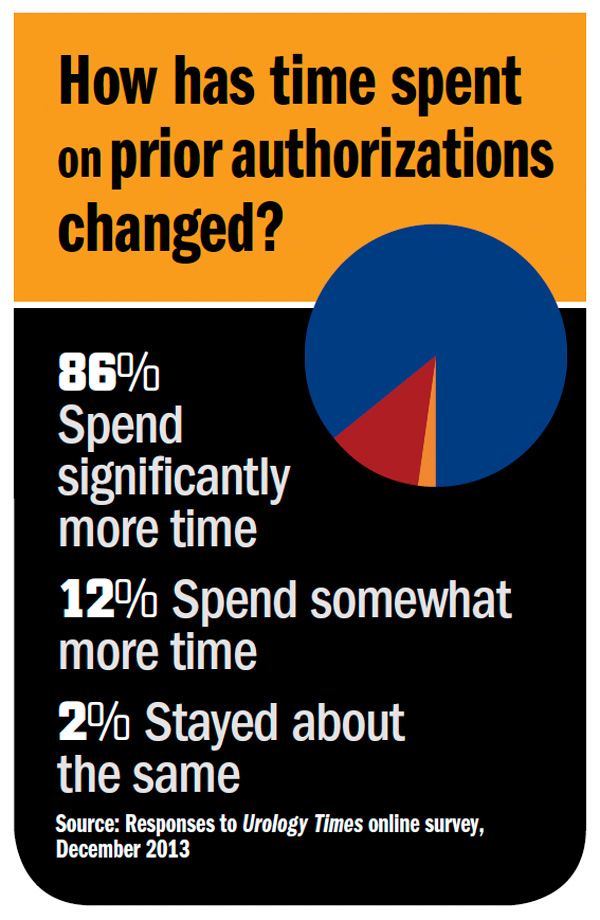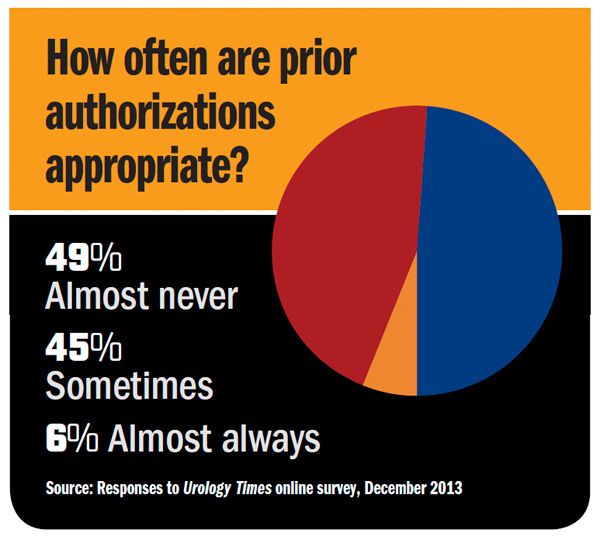Article
Prior authorization blues: Time, money not well spent
Research and anecdotal reports from practicing urologists indicate prior authorization is swelling and becoming increasingly burdensome.
National Report-New Orleans-based urologist Neil H. Baum, MD, remembers administering the prostate cancer drug, leuprolide acetate (Lupron), without prior authorization from the patient’s insurer. The $1,000 he had to pay out of pocket, as a result, still stings.
Dr. Baum admits he and his staff made a mistake when they didn’t secure the authorization first, but adds the practice of getting prior authorization is burdensome for physicians and patients.
“I think this is one of those things that’s really a thorn in the side of the doctor and the practice,” he said.
Steven M. Wahle, MD, a urologist in private practice in Cedar Rapids, IA, described the case of one of his patients, an 88-year-old female with flank pain and hydronephrosis but no stone. A computed tomography scan with contrast was indicated. The payer initially said it would not reimburse the CT scan without prior authorization. Dr. Wahle explained the situation in a phone call to the payer, indicating that a CT with contrast was the standard of care in this case.

Dr. Wahle“Two days later, they called and said we’ll accept the CT with contrast,” said Dr. Wahle, who also serves as chair of quality assurance at Physicians’ Clinic of Iowa and a local hospital. “In the meantime, the patient had 3 days of pain and discomfort. This is the kind of scenario that I see more and more commonly.”
Prior authorizations are unavoidable when physicians of all specialties deal with patients covered by insurance.
And, whether you’re a solo practitioner or in a group practice, chances are you pay a hefty price for prior authorizations. In a study published in Health Affairs (2011; 30:1443-50), researchers found U.S. physicians spent nearly $83,000 annually on interactions with insurers, including prior authorizations. According to the study, U.S. physicians spent an hour a week on prior authorizations, while nursing staff spent 13 hours and clinical staff 6.3 hours.
“Think what urologists could do with an hour of time. They could see three patients in the office or [do] a procedure. So this has an opportunity cost to the provider, as well as a direct cost for the nursing and clerical staff involved in prior authorization,” said study co-author David N. Gans, MSHA, senior fellow of industry affairs at the Medical Group Management Association.
These costs are similar for solo practices and large groups, Gans says.
A growing problem?
Whether prior authorization is a growing trend is unclear, but research and anecdotal reports from practicing urologists indicate it is swelling and becoming increasingly burdensome.
A small online survey conducted by Urology Times last month suggests the practice is not only increasing but is also more time consuming than it was 2 years ago. Eighty-four percent of respondents report that the number of prior authorizations has increased significantly in the past 2 years, and an additional 14% say it’s increased somewhat. Only 2% indicate that the number has stayed the same, and none say it has decreased.

In terms of time spent on prior authorizations by urologists and their staff, 86% of the Urology Times survey respondents say they spend significantly more time on them than they did 2 years ago, 12% spend somewhat more time, and 2% spend about the same amount.

“Not only are we seeing an increase in some of these precertifications for fairly straightforward things, but also we’re now getting data back [from insurers] about cost credentialing and, eventually, fee reductions, depending on how they rate you as a provider,” said Dr. Wahle. “We’re trying to counter that.”
Michael Ferragamo, MD, a urologist and coding and reimbursement expert based in Garden City, NY, says prior authorizations are on the rise.
“It varies among carriers. A lot of carriers want almost everything [precertified],” Dr. Ferragamo said.
Dr. Baum’s staff reports they haven’t noticed an increase in the number of prior authorizations.
Alan D. Winkler, MHSA, executive director of Urology San Antonio, says as reimbursement declines, administrative processes across insurance carriers continue to increase. He says that while the practice has seen a decrease in the number of outpatient procedures requiring preauthorization, they’ve experienced an increase in imaging preauthorization requirements.
“With 27 physicians and six midlevel providers, Urology San Antonio is the largest private provider of urological services in South Texas. It has two full-time employees and three employees working part time to request prior authorization, provide clinical data, and secure approval for a growing number of its services,” Winkler said.
“The long-term trend has been to use prior authorization in a more focused manner. So, there used to be some plans [requiring] prior authorization to see a specialist and such, and that’s less frequently the case,” said Susan M. Pisano, vice president of communications at America’s Health Insurance Plans. “Plans tend to focus their prior authorization on services where there is clear evidence that something is being misused… in a way that is counter to existing evidence, existing guidelines.”
Examples, she says, include high-tech radiology services.
Common targets
Whether a plan will request prior authorization depends on the service, as well as the individual plan.
Dr. Baum’s staff provided Urology Times with a list of common prior authorizations and the plans that request them. Peoples Health, a Medicare provider, requires precertification on all dimethyl sulfoxide (Rimso-50) instillations for interstitial cystitis. Testosterone pellets (Testopel) almost always requires precertification, they say, as do most other forms of testosterone replacement therapy.
And, as Pisano mentioned, imaging and radiology services often send a red flag for prior authorization.
“Many BlueCross BlueShield policies require preauthorizations for medications that are on a ‘step-program,’ meaning they have had to try and fail one to two generic medications before the name brand can be prescribed. Peoples Health requires preauthorizations on certain antibiotics for patients over the age of 70,” Dr. Baum’s staff wrote in an email.
In Cedar Rapids, where BlueCross BlueShield represents about 70% of the commercial market, prior authorizations always relate to an imaging study in Dr. Wahle’s experience. “CT imaging is really on their radar screen now. I have not gotten calls on surgical procedures,” he said.
A reasonable request?
Preventing misuse or overuse with prior authorization, according to Pisano, is in patients’ best interests. There is evidence, she says, suggesting that misuse or overuse of some high-tech radiology services could be a contributing factor to some cancers.
“What we’re looking at is both a patient safety/quality of care issue and an affordability issue. When you begin to see that it’s both of those things, that’s where plans tend to focus the requirements and resources to carry out prior authorization,” Pisano said.
Dr. Ferragamo agrees there are good motives for prior authorization but says carriers should not be driving medical judgment.
“When they say, ‘I don’t think you need this drug or CT scan,’ they’re taking the medical decision making out of the hands of the person examining the patient,” he said. “I think [prior authorization] is an attempt to control costs. It’s an attempt to prevent overuse of expensive treatments and diagnostic studies, and it’s really almost an attempt to micromanage to a degree, because they’re calling the shots.”
Privately, a number of other urologists told Urology Times that prior authorizations are simply an attempt by third-party payers to “game the system”-a way to delay or even avoid reimbursement. One urologist said a representative of a large insurer even admitted to him that the authorization process results in very few denials on the basis of merit; rather, the majority are carried out to reduce the use of imaging tests and, ultimately, payment.
In the Urology Times survey, just under half (45%) of respondents said they believe prior authorizations are “sometimes” appropriate, while a slightly higher percentage (49%) said they “almost never” are.

Another big issue for urologists: process inefficiency and the time it takes to get approvals.
Urology San Antonio’s Winkler says that while there are similarities among insurance carriers, there is no national standardized list of services requiring preauthorization and no standardized list of data elements required to secure approval.
“For example, a Medicare prior authorization typically takes about 5 minutes,” Winkler said. “In contrast, the typical commercial insurance prior authorization easily can take 15 minutes per case, with much of that time spent on hold. Some carriers encourage providers to utilize online capability; however, these typically permit only one prior authorization request per session. Phone requests require on-hold time but provide the opportunity to secure up to 10 authorizations per session.”
Winkler adds, when documentation is required, which is occurring more frequently, responses can take up to 2 days for routine urologic procedures. Some Medicare replacement plans take up to 5 days for approval of certain procedures.
“While this may seem inconsequential, one of Urology San Antonio’s employees processed 298 of those requests in July 2013. Another employee completed 169 preauthorizations during the same month,” Winkler said.
For complicated cases involving sacral neuromodulation (InterStim), onabotulinumtoxinA injections (Botox), bone health, drugs for prostate cancer, and prosthetic implants, preauthorizations often take up to 30 minutes each and typical turnaround is 14 days, according to Winkler.
“Despite the administrative challenges, 80% of these cases are approved initially or as soon as medical necessity is established. Involvement of the surgeon occurs in the remaining instances,” Winkler said.
Of the 20% not initially approved, about 60% are ultimately approved.
The cost of providing the support services to get approval is not reflected in the reimbursement rates, according to Winkler.

“This process of keeping people on the phone for a half-hour or in excess of a half-hour… that’s just inefficient use of health care dollars,” Dr. Baum said.
“If an insurance company has to review the case for either medications or procedures, it could take up to 72 hours for them to get a response to us, delaying the patient getting his medication even longer. If an appeal has to be submitted, it could take weeks, if not a month for a response,” according to a written statement by members of Dr. Baum’s office staff.
Some doctors will give up the fight after the first appeal, Dr. Ferragamo says.
“That’s bad in the sense that maybe the patient doesn’t get the drug, treatment, or diagnostic study that he really may need,” he said.
Potential solutions
Pisano says that she thinks it’s in plans’ interest to try to work with health care providers to minimize the number of services for which prior authorization is needed. Sometimes, plans will provide decision support tools to physicians, she says.
Dr. Ferragamo says delegating prior authorization responsibilities to specially trained staff can help to streamline the process. Dr. Wahle notes that this is not always possible, and that some insurers have very recently insisted on speaking directly with the treating physician. He said he follows an aggressive, carefully planned process in dealing with payers that has proven highly successful.
One big-picture solution is to model our system after Canada’s, according to Gans. The higher costs associated with payer interactions in the U.S. seem to be related to this country’s multi-payer system. The 2011 Health Affairs study found physician practices in Ontario spent only $22,205 per physician per year interacting with Canada’s single-payer system. That’s just 27% of the time amount U.S. physician practices spent. And Canadian nursing staff and medical assistants spent nearly one-tenth the time U.S. practice staffs spent each year on those interactions.
The finding supports the call for greater efficiency in the U.S., Gans says.
“You can use Canada as an external benchmark and say what would be the differential if the United States had a more simplified, similar system-still allowing insurers to compete on price and perhaps service but [with] a standardized process of bill processing,” Gans said. “Canadians spend nothing on prior authorization. If the doctor deems it necessary, it is paid. My understanding is that they’re far more involved in retrospective assessment than prospective.”
Light at the tunnel’s end?
While Pisano says it’s hard to predict how changes in health care will impact prior authorization, she believes automation and, potentially, new care models could have a positive impact.
“Depending on how these new models develop, it could be that there is less need for prior authorization,” she said. “But it also may be for the foreseeable future there is a need to have prior authorization, at least on a selected basis.”
Electronic health records and electronic prescribing systems should lower costs associated with prior authorization and formularies, Gans says.
“Oftentimes, it’s more automated in an electronic prescribing system. The same for electronic health records-the documentation is more easily extracted and provided,” Gans said.
For now, however, prior authorization remains a headache for many urologists. Dr. Baum says it is just one more responsibility that might end up on patients’ laps. Doctors, he says, will simply give patients the necessary documentation and let patients handle the interactions with payers.UT
Subscribe to Urology Times to get monthly news from the leading news source for urologists.
2 Commerce Drive
Cranbury, NJ 08512
All rights reserved.





